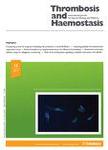版权所有:内蒙古大学图书馆 技术提供:维普资讯• 智图
内蒙古自治区呼和浩特市赛罕区大学西街235号 邮编: 010021

作者机构:Scripps Res Inst Dept Vasc Biol La Jolla CA 92037 USA
出 版 物:《THROMBOSIS AND HAEMOSTASIS》
年 卷 期:1999年第82卷第2期
页 面:742-747页
核心收录:
学科分类:1002[医学-临床医学] 1001[医学-基础医学(可授医学、理学学位)] 10[医学]
主 题:脂肪组织 糖尿病 2型 疾病模型 动物 基因表达 止血/遗传学 肥胖症/并发症 肥胖症/遗传学 纤溶酶原激活物抑制物1 转化生长因子β 肿瘤坏死因子α 血管疾病/病因学 血管疾病/遗传学 动物 人类 小鼠
摘 要:Obesity is a major public health problem in Western societies with substantial economic consequences. In the United States alone, over 30% of the population is defined as clinically obese, and thereby, are subject to increased risk for obesity-associated disorders, including cardiovascular disease (CVD), hypertension, insulin resistance, and non-insulin dependent diabetes mellitus (NIDDM).1,2 In spite of the magnitude of this problem, the molecular changes in obesity that promote these conditions are far from resolved. The fact that human obesity is a polygenic disorder with complex environmental and behavioral characteristics has made obesity research one of the more difficult areas of investigation in the medical sciences.1,3 However, recent studies of genetically obese mice and rats have produced breakthroughs in several areas of obesity-related research, primarily because obesity in these animals appears to be monogenic (i.e., to result from mutations in single genes). In this regard, five different genes, all mapped to different chromosomal locations, have been shown to cause distinct syndromes of spontaneous obesity with severe insulin resistance in mice.3 These include the obese (ob), diabetes (db), tubby (tub), lethal yellow (Ay) and fat (fat) mutations. Genes encoding intercellular adhesion molecule 1 (ICAM-1) and the leukocyte integrin αmβ2 (MAC-1) also have been implicated in the regulation of adipose tissue mass.4 These animal studies, together with studies of cultured adipocytes, have provided fundamental new information about the factors and cells that may be responsible for the altered hemostatic balance leading to increased cardiovascular risk in obesity/NIDDM. In this chapter, we summarize our studies on plasminogen activator inhibitor 1 (PAI-1), tissue factor, and transforming growth factor (TGF)-β expression in obesity, using genetically obese mice as a model. These studies emphasize the key role played by the adipocyte, a cell whose numbers, siz